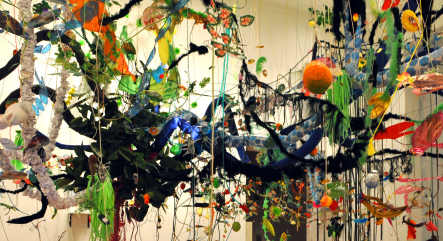“The Tropics” arrives in the German capital at just the right moment. As Berlin heads again into its long and often brutal Prussian winter, this large exhibition offers a cheaper form of escapism then a plane ticket to Rio de Janeiro.
Fittingly, the first thing viewers see when they walk into the show is a tall plastic palm tree, a pile of breezy magazines and an inviting-looking wooden bench, all components of Franz Ackermann’s “Terminal Tropical” installation.
The stated aim of the new exhibition is to bring works of contemporary art “into dialogue” with assorted pre-modern artefacts stolen over the centuries from various tribes, by grouping them together into seven themed sections.
This is sometimes pretty dumb. For instance, in the section “After the Flood” a Hans-Christian Schink photograph of an Amazonian waterfall is set alongside a Fiona Tan video work showing rain filling a bucket, and a fourteenth century stone statue of the Aztec Rain God Tlaloc.
In general, the inclusion of the primitive artefacts seems to me a mistake, as the main role they serve here is only to demonstrate once again that contemporary art can cheerfully consume anything. But this key criticism aside, at other points “The Tropics” succeeds spectacularly. For example, the exhibition shows the ways in which modern civilization is itself weirdly primitive.
This point is particularly well made by Gerda Steiner and Jörg Lenzlinger’s sculptural installation “Bürokult.” Depicting an office-cum-rainforest in which wires are creepers, computers sprout corals and ceremonial masks are studded with mobile phone, the piece takes its name from the infamous cargo cults of Polynesia, who built wooden airstrips and towers after the Second World War in a copy-cat bid to induce American cargo planes to return with more goods.
The Polynesians were disappointed. But they are not alone. What Steiner and Lenzlinger’s installation suggests is that the various rituals of the information age are not really a great deal more rational than the fetish objects and rites of the pre-scientific societies that preceded it. And in this, they are surely onto something. Consider: How many times have you checked your e-mail today?
Where “The Tropics” show as a whole is especially effective is in summoning a series of richly contrasting moods and in supplying through that a feeling of travel.
While “Bürokult” evokes the lushness of jungles, the neatly stockpiled goods of Mark Dion’s “Jungle Shop” with its pencils, cleavers, shovels, condensed milk, instant noodles instils a sense of frontier utility. Equally, at another point in the show, Mauricio Dias and Walter Riedweg’s panoramic four-screen video installation “Camera Felicia” creates the feeling of being in a bustling South American square.
In this world shrunk by technology, far-flung places are becoming ever-more strangely familiar. One of the major ironies of this show is the recurrence of various western symbols. In Pieter Hugo’s photos of the Techimen district of Ghana one of the wild honey collectors wears a Mickey Mouse t-shirt. On the other side of the entertainment divide, the dancer in David Zink Yi’s video of a Cuban alleyway party is shown dressed in a Star Wars t-shirt.
A few hundred years ago, at the height of European modernity, the Tropics were fantasized as terrestrial paradises. But today, in the form of the megaslums of Lagos and Sao Paulo, they are fast becoming something else, the full implications of which are not yet entirely clear. The last section of this show – entitled “The Urban Drama” – drives that point home.
“We now come to a point where old arts fall silent,” the curator’s inscription states ominously, apparently recognizing that there are no maps for these “urban jungles” in the truest sense of that phrase.
More information
“The Tropics: Views from the Middle of the Globe” runs at the Martin-Gropius Bau until January 5, with additional events scheduled throughout Berlin.
Opening Hours
Wednesday to Monday | 10–20 hrs
Tuesday closed
Closed Wed 24 and 31 Dec
Open Tue 30 Dec
Admission
€ 6.00 | € 4.50 reduced
Combined ticket with audio guide
€ 9.00 | € 7.50 reduced



 Please whitelist us to continue reading.
Please whitelist us to continue reading.